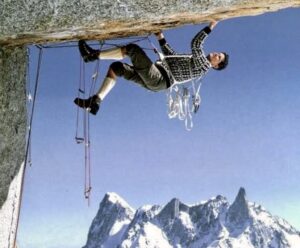What do NASA, the European Space Agency, the Himalayan Stove Project and the Explorers Club have in common? For one, they are all involved in Swedish mountaineer Carina Ahlqvist’s latest endeavour, a scientific and cultural expedition designed to collect tangible climate change data in the Makalu region of Nepal.
Carina is leading a team of 11 on the traditional Makalu Base Camp trek, and will then continue alone except for a small Sherpa team in an attempt to summit the 8,481 m peak. The expedition’s primary objective will be to obtain accurate measurements of essential climate variables, to help researchers better understand climate change in the Himalaya.

Carina Ahlqvist has been on four 8,000 m expeditions in the Himalaya. She will be leading a trekking team of 11 to Makalu Base Camp. Photo: Carina Ahlqvist
An official Flag Expedition of the Explorers Club, and with support from NASA and the European Space Agency, Carina’s project will gather rock samples from the Barun Glacier at Makalu Base Camp, as well as higher altitude readings from Advanced Base Camp. These samples from historical debris will help date the glacier and allow scientists to reconstruct previous climatic conditions and predict future changes to the region’s glaciers.

A view of Makalu from Base Camp. Experiments are planned here and at ABC (Advanced Base Camp). Photo: Kit DesLauriers
While only Carina will continue above Makalu Base Camp, the other trekkers will pursue their own objectives. This group includes Joanne Galka and Pamela Johnston from the Himalayan Stove Project (HSP), a not-for-profit organization that donates clean-burning, fuel-efficient cookstoves to rural families in Nepal. Among other things, they will check on a recent HSP project in the Makalu region, inspired by renowned ski mountaineer Kit DesLauriers, the first person to ski down the Seven Summits.
DesLauriers had been forced to spend a number of days recovering in the village of Yangri Kharka after her attempt on Makalu in 2015. After returning to the United States, she was anxious to repay the Nepalese hospitality by helping provide cookstoves to the 140 households in the region.
The HSP representatives will review how the initial 25 stoves are performing and report back on fuel efficiency and performance at altitude, as well as how the stoves have impacted local families.

Typically, homes in Yangri Kharka use open fires for cooking. This can cause serious health issues for families breathing so much smoke indoors. Photo: Kit DesLauriers
After an initial delay due to weather, and a 10-hour journey by 4WD to the trailhead, the team spent their first night at Num. Check out the links below to learn more about the Himalayan Stove Project.
Previous / Links:
Joanne Galka’s HSP Fundraising Page
The Makalu Clean-Cook Stove Initiative






